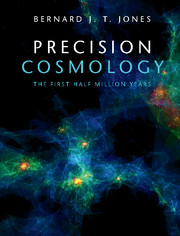Book contents
- Frontmatter
- Dedication
- Contents
- Preface
- Notation and Conventions
- Part I 100 Years of Cosmology
- Part II Newtonian Cosmology
- Part III Relativistic Cosmology
- 10 Minkowski Space
- 11 The Energy Momentum Tensor
- 12 General Relativity
- 13 Space-Time Geometry and Calculus
- 14 The Einstein Field Equations
- 15 Solutions of the Einstein Equations
- 16 The Robertson–Walker Solution
- 17 Congruences, Curvature and Raychaudhuri
- 18 Observing and Measuring the Universe
- Part IV The Physics of Matter and Radiation
- Part V Precision Tools for Precision Cosmology
- Appendix A SI, CGS and Planck Units
- Appendix B Magnitudes and Distances
- Appendix C Representing Vectors and Tensors
- Appendix D The Electromagnetic Field
- Appendix E Statistical Distributions
- Appendix F Functions on a Sphere
- Appendix G Acknowledgements
- References
- Index
16 - The Robertson–Walker Solution
from Part III - Relativistic Cosmology
Published online by Cambridge University Press: 04 May 2017
- Frontmatter
- Dedication
- Contents
- Preface
- Notation and Conventions
- Part I 100 Years of Cosmology
- Part II Newtonian Cosmology
- Part III Relativistic Cosmology
- 10 Minkowski Space
- 11 The Energy Momentum Tensor
- 12 General Relativity
- 13 Space-Time Geometry and Calculus
- 14 The Einstein Field Equations
- 15 Solutions of the Einstein Equations
- 16 The Robertson–Walker Solution
- 17 Congruences, Curvature and Raychaudhuri
- 18 Observing and Measuring the Universe
- Part IV The Physics of Matter and Radiation
- Part V Precision Tools for Precision Cosmology
- Appendix A SI, CGS and Planck Units
- Appendix B Magnitudes and Distances
- Appendix C Representing Vectors and Tensors
- Appendix D The Electromagnetic Field
- Appendix E Statistical Distributions
- Appendix F Functions on a Sphere
- Appendix G Acknowledgements
- References
- Index
Summary
Our standard cosmological model describes a Universe that, in the large, is homogeneous and isotropic and filled with a variety of kinds of matter. Among the various matter fields that we can readily identify are baryons, photons and neutrinos. There are in addition components for which we have indirect yet compelling evidence, namely dark matter and dark energy. The dynamics of the Universe is governed by the law of gravitation: Einstein's general relativity (GR) or perhaps some variant thereof.
The GR Robertson–Walker metric finds its origins in the famous works of Fried-mann and Lemaître, but it was Robertson and Walker who independently set the model on a firm mathematical footing. The Robertson–Walker metric is the fundamental general relativistic basis of modern cosmology. It provides the framework within which all observations are interpreted and all observational tests of the underlying cosmology carried out so far can be fit to this model.
Here we will refer to this solution of the Einstein equations as the ‘FLRW metric’. We have already encountered the Robertson–Walker metric in Section 15.4.1.
The Metric in Diverse Coordinate Systems
We are, in general relativity, at liberty to choose whichever coordinate system is best adapted to solving a particular problem. The physics of the FLRW solution cannot depend on any specific coordinate choice, but the way in which the values are assigned to measurements will depend on the specific coordinate system. Choosing a particular set of coordinates is a matter of convenience.
One of the issues is to come to terms with the variety of different coordinates systems which have been used to describe the FLRW metric. In this section we present the most important of these representations of the FLRW metric. We go on to discuss the concepts of distance within this framework and touch on the subject of how perturbations to the metric will evolve during the cosmic expansion.
Information
- Type
- Chapter
- Information
- Precision CosmologyThe First Half Million Years, pp. 386 - 410Publisher: Cambridge University PressPrint publication year: 2017
